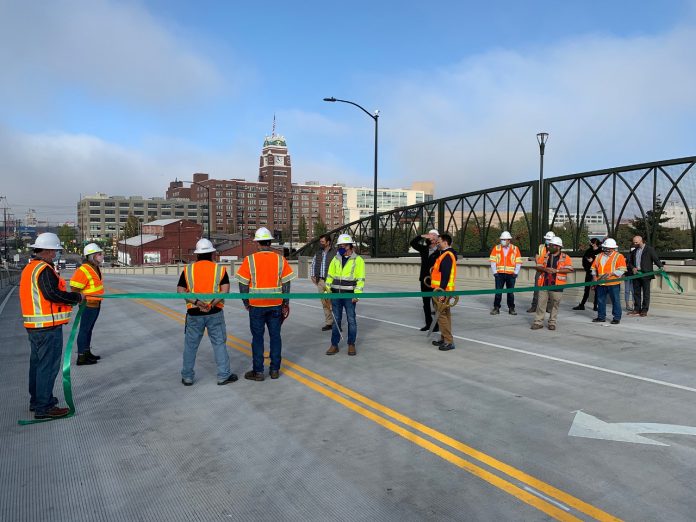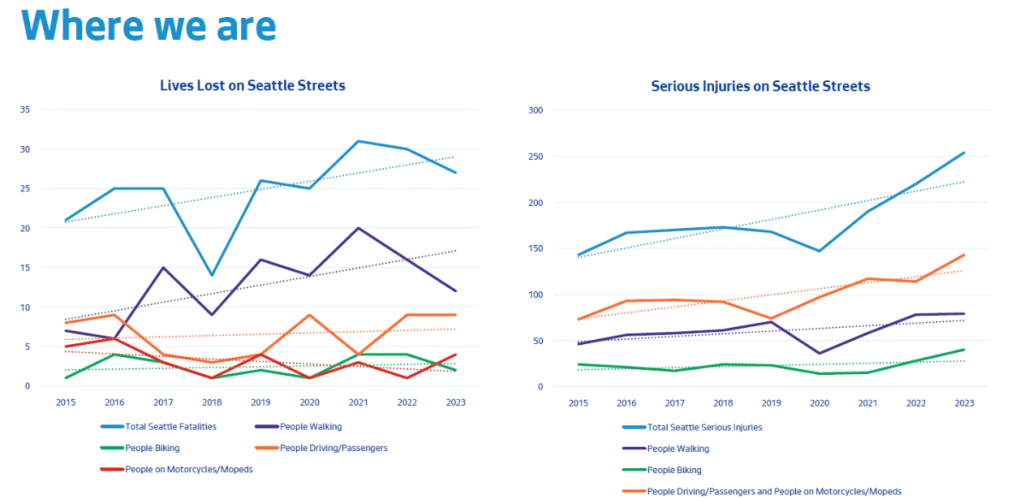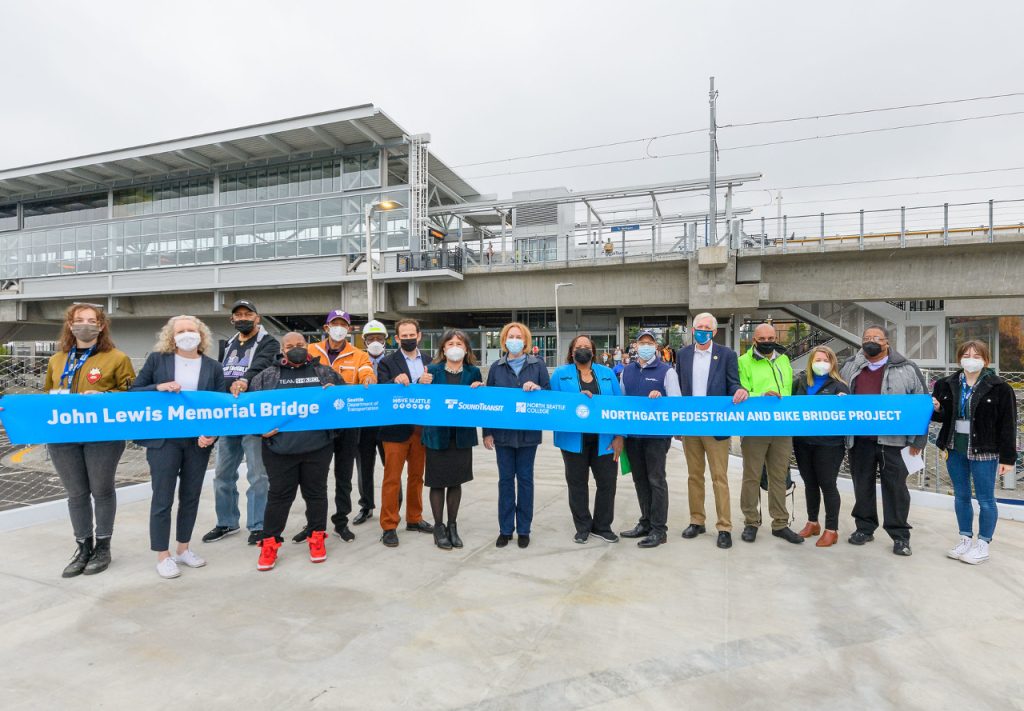
The oversight body tasked with stewarding Seattle’s $930 million Move Seattle transportation levy has recommended the City pursue a transportation funding package broader than just the planned renewal of the existing levy, set to expire this fall. In a letter approved this week, the Move Seattle Levy Oversight Committee told city leaders that it strongly recommends a renewal levy, but that the city’s transportation needs go well beyond the capacity of property tax levies being considered.
Submitting recommendations for a follow-up levy is one of the main charges given to the Move Seattle Levy Oversight Committee in 2015’s authorization ordinance. The letter outlining those recommendations has been developing over the past several months as the Seattle Department of Transportation (SDOT) has released public polling showing strong voter appetite for renewal, with a clear majority of voters supporting a $1.7 billion levy that would increase resources for SDOT, and close to a supermajority support a $1.2 billion levy that adjusts the total amount from Move Seattle for inflation.
“The levy is not sufficient to meet Seattle’s transportation infrastructure requirements We recommend a transportation package, including a future levy, that would address our markedly deteriorating infrastructure After many years of under-investment in basic road and bridge maintenance, our arterials, non-arterials and bridges need a significant course change to arrest their decline, and begin to catch up on these needs,” the letter reads (emphasis in original).
Their recommendation seems in line with transportation advocates, who are urging a $3 billion levy in order to allow the City to make progress on its safety, greenhouse gas reduction, and walkability goals over the coming years, arguing that now is not the time to continue treading water. But it seems out of step with Seattle Mayor Bruce Harrell and moderate city councilmembers who have preached fiscal conservatism.
“While there are some who would suggest that the answer lies simply in new revenue, the fact is that passing a new or expanded tax will not address the fundamental issues needed to close this gap in the long-run,” Harrell said in his “State of the City” address last month.
And yet the City continues to fall behind on transportation investments. Data presented to the committee Tuesday night showed that between 2004 and 2023, the share of arterial pavement in either “poor” or “very poor” condition jumped nearly 10 percentage points, from 28.7% to 38.6%. SDOT estimates the number of lane-miles in need of full reconstruction, the most expensive way to maintain roadways, at 286 miles as of last year, with the cost to fully restore pegged at a staggering $1.4 billion.
The Move Seattle Levy has provided $250 million directly to arterial repaving and maintenance, over 25% of the levy’s total amount, with more funding provided for maintenance — and full street rebuilds — on the city’s signature transit investment projects like RapidRide G Line and upgrades to the Route 40.

The levy oversight committee is also pressing for more transportation revenue to allow the City to be able to ramp up investments in traffic safety. “The levy is also not sufficient to meet Seattle’s safety goals,” their letter states. “We recommend that a future transportation package, including a future levy, address the ongoing deaths and serious injuries sustained by people using all transportation modes. Despite the City’s goal of ending traffic deaths and serious injuries on city streets by 2030, traffic fatalities have steadily increased over the last ten years.”
Data presented by SDOT’s Vision Zero team this week shows that serious injuries from traffic collisions in Seattle hit another recent high in 2023, as the total number of traffic fatalities dipped slightly for the second year in a row. The overall upward trajectory follows statewide trends, as total roadway fatalities in Washington last year are set to exceed 800, a number not seen in 30 years.

With the City facing annual budget deficits approaching $250 million per year starting in 2025, budget writers might look to fill some of that gap by backfilling a general fund shortfall with dedicated funding sources like Move Seattle, the Seattle parks district, or the library levy. But Move Seattle includes a supplantation clause, barring the City from allocating funds from Move Seattle if a certain amount of general fund dollars haven’t been allocated to transportation. The oversight committee wants to see that practice continue.
The oversight committee recommended the City look at a broad range of transportation funding options, including adding tolls to city bridges, implementing road congestion pricing, and approving transportation impact fees. But none of the sources received the group’s endorsement, as they note additional analysis would be required to evaluate them against other options.
“The [levy oversight committee] recommends the city consider and adopt other funding tools to work in tandem with a future levy,” their letter states. “Some can benefit short-term projects, such as ‘safe routes to school,’ which are a product of the recent levy, and should be continued by a future levy. Others can benefit multiple generations by funding high value projects, such as bridges.”
Mixed signals are coming from the Seattle City Council when it comes to transportation funding. Many of the councilmembers who started their first terms this year have voiced a desire to see the city double down on maintenance before starting new projects.
“I strongly support localized Seattle implementation of the Biden administration fix-it-first approach to infrastructure and planning investments, at a very high level, which means let us fix the existing assets and infrastructure first before either building net new assets or chaining on new features on top of existing, crumbling assets,” Councilmember Rob Saka, chair of the transportation committee, said in February.
But those councilmembers are likely to quickly find that it’s not so simple, with dollars regularly available for new projects that simply wouldn’t be able to be used for maintenance, and roadway or utility upgrades regularly tied together with infrastructure upgrades. So far, none have been open about which projects they think the City should have decided against pursuing. Meanwhile, their more senior colleague, Dan Strauss, was open this week about the fact that the next transportation levy won’t be enough to address another critical need the City faces: bridge maintenance.

“Big picture, we have enough operations, maintenance, and repairs that we should probably have a bridge levy dedicated to itself,” Strauss said Tuesday. “The consistent funding stream for ensuring operations and maintenance is occurring, proactively, is just not there, and that’s a structural error.”
Move Seattle Levy campaign materials hinted at, without outright promising, seismic upgrades to the Ballard and Fremont Bridges, but after new cost estimates put those projects well out of range compared to available funding, SDOT pivoted to delivering more achievable bridge upgrades, still hitting the total number promised to voters. Longer term, a study looking at the full replacement for the Ballard Bridge found costs could add up to $1.4 billion, and those are 2019 dollars. A full replacement of the Magnolia Bridge is likely to cost a similar amount.
Even as the political winds seem to push back against bold action, there’s broad agreement that things won’t improve without a change in approach. The coming months will show just how much appetite there actually is to make progress.
Ryan Packer lives in the Summit Slope neighborhood of Capitol Hill and has been writing for the The Urbanist since 2015. They report on multimodal transportation issues, #VisionZero, preservation, and local politics. They believe in using Seattle's history to help attain the vibrant, diverse city that we all wish to inhabit. Ryan's writing has appeared in Capitol Hill Seattle Blog, Bike Portland, and Seattle Bike Blog, where they also did a four-month stint as temporary editor.

